CR6
(possibly NWA 011-related) 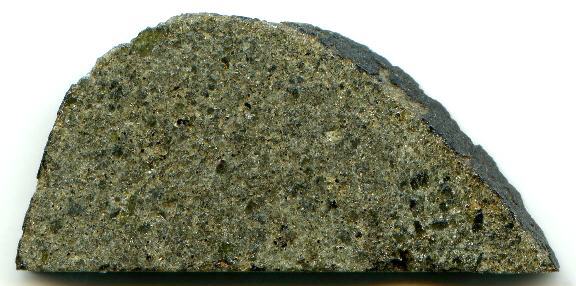
click on photo for a magnified view Purchased June 2012
no coordinates recorded
A single
meteoriteWork in progress. A solid natural object reaching a planet’s surface from interplanetary space. Solid portion of a meteoroid that survives its fall to Earth, or some other body. Meteorites are classified as stony meteorites, iron meteorites, and stony-iron meteorites. These groups are further divided according to their mineralogy and Click on Term to Read More weighing 1,096 g was purchased in Morocco by T. Jakubowski and M. Cimala of PolandMet. The stone was analyzed at the University of Washington in Seattle (A. Irving) and NWA 7317 was classified as a recrystallized, texturally evolved CR6
chondriteChondrites are the most common meteorites accounting for ~84% of falls. Chondrites are comprised mostly of Fe- and Mg-bearing silicate minerals (found in both chondrules and fine grained matrix), reduced Fe/Ni metal (found in various states like large blebs, small grains and/or even chondrule rims), and various refractory inclusions (such Click on Term to Read More paired to NWA 2994 [4,756 g], NWA 3250 [916 g], NWA 6901 [1,197 g], and NWA 6921 [1,749 g] (T. Bunch and J. Wittke, NAU; A. Irving, UWS). At least one other stone presumed to belong with this pairing group remains to be studied. This pairing group constitutes one of only a few rare CR6
chondritesChondrites are the most common meteorites accounting for ~84% of falls. Chondrites are comprised mostly of Fe- and Mg-bearing silicate minerals (found in both chondrules and fine grained matrix), reduced Fe/Ni metal (found in various states like large blebs, small grains and/or even chondrule rims), and various refractory inclusions (such Click on Term to Read More to be classified. See a photo of
two whole stones exhibited in the ‘Encyclopedia of Meteorites’ by Marcin Cimala. As with
NWA 3100, NWA 7317 and pairings contain evidence of relict barred
chondrulesRoughly spherical aggregate of coarse crystals formed from the rapid cooling and solidification of a melt at ~1400 ° C. Large numbers of chondrules are found in all chondrites except for the CI group of carbonaceous chondrites. Chondrules are typically 0.5-2 mm in diameter and are usually composed of olivine Click on Term to Read More in
thin sectionThin slice or rock, usually 30 µm thick. Thin sections are used to study rocks with a petrographic microscope., logically disqualifying it as a ‘primitive’
achondriteAn achondrite is a type of stony meteorite whose precursor was of chondritic origin and experienced metamorphic and igneous processes. They have a planetary or differentiated asteroidal origin where the chondritic parent body reached a sufficient size that through heating due to radioactive decay of 26Al (aluminum isotope) and gravitational Click on Term to Read More, and not meeting the requisite advanced thermal metamorphism to be termed a type 7 or
metachondriteTerm used to describe a metamorphosed chondrite. Also referred to as a type 7 chondrite. Metachondrites are texturally evolved rocks derived from chondritic precursors and some have been classified as primitive achondrites. Click on Term to Read More.
This meteorite has been very weakly shocked (S2) and has experienced very minor terrestrial weathering (W0/1). The
oxygenElement that makes up 20.95 vol. % of the Earth's atmosphere at ground level, 89 wt. % of seawater and 46.6 wt. % (94 vol. %) of Earth's crust. It appears to be the third most abundant element in the universe (after H and He), but has an abundance only Click on Term to Read More isotopic composition for NWA 7317 was determined at the Carnegie Insitution in Washington DC (D. Rumble, III;
CR chondrite comparison plot), while that of NWA 3250
CR chondrite comparison plot) was previously determined at the Open University, UK (I. Franchi and R. Greenwood; Δ
17O = –1.72). Including the plot from NWA 3100 (University of Western Ontario; T. Larson and F. Longstaffe), they all
fallMeteorite seen to fall. Such meteorites are usually collected soon after falling and are not affected by terrestrial weathering (Weathering = 0). Beginning in 2014 (date needs confirmation), the NomComm adopted the use of the terms "probable fall" and "confirmed fall" to provide better insight into the meteorite's history. If Click on Term to Read More within the field for CR chondrites. The anomalous achondrites Tafassasset and LEW 88763 are also geochemically and isotopically related to the CR
parent bodyThe body from which a meteorite or meteoroid was derived prior to its ejection. Some parent bodies were destroyed early in the formation of our Solar System, while others like the asteroid 4-Vesta and Mars are still observable today. Click on Term to Read More, but they have experienced a higher degree of thermal metamorphism and recrystallization. Since relict chondrules have now been reported in the texurally-evolved Tafassasset (as well as in LEW 88763), it would perhaps be more appropriately termed CR6 as well.
A cooperative study was undertaken of a number of previously
ungroupedModifying term used to describe meteorites that are mineralogically and/or chemically unique and defy classification into the group or sub-group they most closely resemble. Some examples include Ungrouped Achondrite (achondrite-ung), Ungrouped Chondrite (chondrite-ung), Ungrouped Iron (iron-ung), and Ungrouped Carbonaceous (C-ung). Click on Term to Read More achondrites, primitive achondrites, and silicated irons which have O-isotopic compositions that plot along the CR oxygen
isotopeOne of two or more atoms with the same atomic number (Z), but different mass (A). For example, hydrogen has three isotopes: 1H, 2H (deuterium), and 3H (tritium). Different isotopes of a given element have different numbers of neutrons in the nucleus. Click on Term to Read More trend line (Bunch
et al., 2005—Northern Arizona University, University of Washington, and University of Western Ontario). From the meteorites that were studied, including NWA 3100, NWA 801, Tafassasset, NWA 011 pairing group, LEW 88763, Sombrerete, and NWA 468, it was determined that some or all of them may have originated in the
coreIn the context of planetary formation, the core is the central region of a large differentiated asteroid, planet or moon and made up of denser materials than the surrounding mantle and crust. For example, the cores of the Earth, the terrestrial planets and differentiated asteroids are rich in metallic iron-nickel. Click on Term to Read More,
mantleMain silicate-rich zone within a planet between the crust and metallic core. The mantle accounts for 82% of Earth's volume and is composed of silicate minerals rich in Mg. The temperature of the mantle can be as high as 3,700 °C. Heat generated in the core causes convection currents in Click on Term to Read More,
crustOutermost layer of a differentiated planet, asteroid or moon, usually consisting of silicate rock and extending no more than 10s of km from the surface. The term is also applied to icy bodies, in which case it is composed of ices, frozen gases, and accumulated meteoritic material. On Earth, the Click on Term to Read More, and chondritic
regolithMixture of unconsolidated rocky fragments, soil, dust and other fine granular particles blanketing the surface of a body lacking an atmosphere. Regolith is the product of "gardening" by repeated meteorite impacts, and thermal processes (such as repeated heating and cooling cycles). Click on Term to Read More of a large, at least partially differentiated CR-type parent body that was subsequently collisionally disaggregated. Compared to all other meteorite groups, both CR chondrites and IIC irons have significant δ
183W excesses, have elevated δ
15N, and share similar Mo isotope systematics, and therefore a genetic link is inferred (Kruijer
et al. (2017; Budde
et al., 2018).
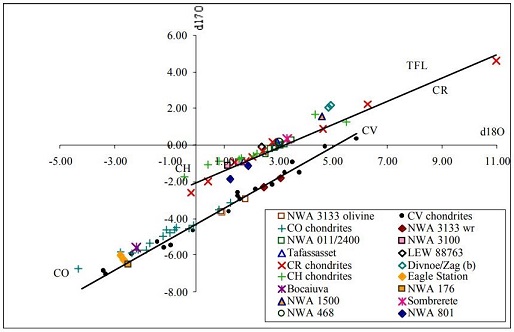 click on photo for a magnified view
click on photo for a magnified view
Diagram credit: Bunch
et al., 36th LPSC,
#2308 (2005) Continued research on this front has been ongoing (
e.g., Bunch
et al., 2005; Floss
et al., 2005, [
MAPS vol. 40, #3]; Irving
et al., 2014 [
#2465]; Sanborn
et al., 2014 [
#2032]). As provided in the Sanborn
et al. (2014) abstract, a coupled Δ
17O
vs. ε
54Cr diagram is one of the best diagnostic tools for determining genetic relationships among meteorites. Moreover, Sanborn
et al. (2015) demonstrated that ε
54Cr values are not affected by aqueous alteration. The diagrams below include the NWA 7317 pairings NWA 6901, 6921, and NWA 2994, and it is apparent that they plot within the
CR chondriteClass named for the Renazzo meteorite that fell in Italy in 1824, are similar to CMs in that they contain hydrous silicates, traces of water, and magnetite. The main difference is that CRs contain Ni-Fe metal and Fe sulfide that occurs in the black matrix and in the large chondrules Click on Term to Read More field.
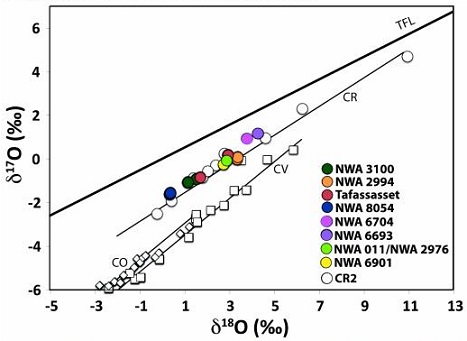
Diagram credit: Sanborn
et al., 45th LPSC,
#2032 (2014)
17O vs. ε54Cr and ε50Ti for CR Carbonaceous Achondrites 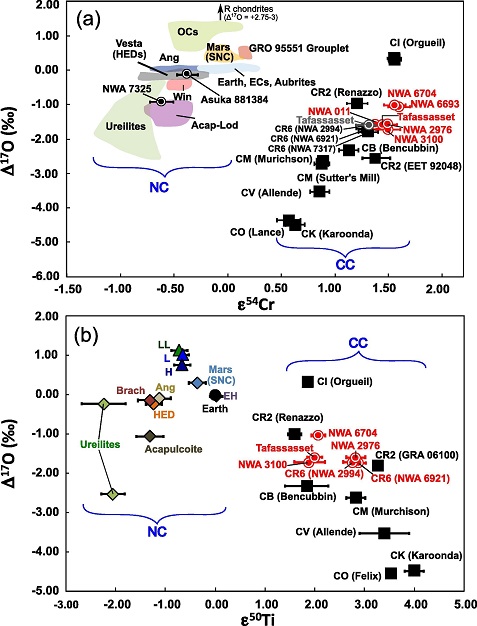 click on image for a magnified view
click on image for a magnified view
Diagrams credit: Sanborn
et al.,
GCA, vol. 245, pp. 577–596 (2019)
‘Carbonaceous Achondrites Northwest Africa 6704/6693: Milestones for Early Solar SystemThe Sun and set of objects orbiting around it including planets and their moons and rings, asteroids, comets, and meteoroids. Chronology and Genealogy’
(https://doi.org/10.1016/j.gca.2018.10.004) However, results of a study of the paired meteorite NWA 6901 conducted by J. Zipfel (2014,
#5346) led to a different conclusion. He determined that despite having similar oxygen and chromium isotopic values, this meteorite has a major
elementSubstance composed of atoms, each of which has the same atomic number (Z) and chemical properties. The chemical properties of an element are determined by the arrangement of the electrons in the various shells (specified by their quantum number) that surround the nucleus. In a neutral atom, the number of Click on Term to Read More composition that is inconsistent with a derivation from a CR-like source. He suggests that the infiltration of a trace element-rich melt phase similar to that of the phosphates present in the ungrouped achondrite NWA 011 (possibly CR-related) could explain the trace element abundance pattern of NWA 6901. These two meteorites also plot near each other on a coupled Δ
17O
vs. ε
54Cr diagram (see above), and therefore he proposes that these meteorites might be related.
The specimen of NWA 7317 shown above and in the top photo below is a 3.07 g partial slice. The excellent photos at the bottom show the
main massLargest fragment of a meteorite, typically at the time of recovery. Meteorites are commonly cut, sliced or sometimes broken thus reducing the size of the main mass and the resulting largest specimen is called the "largest known mass". Click on Term to Read More and a petrographic thin section micrograph of NWA 7317.
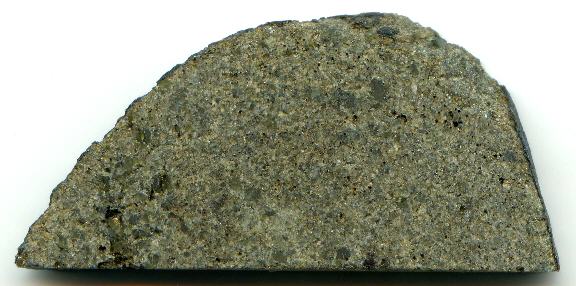
click on photo for a magnified view
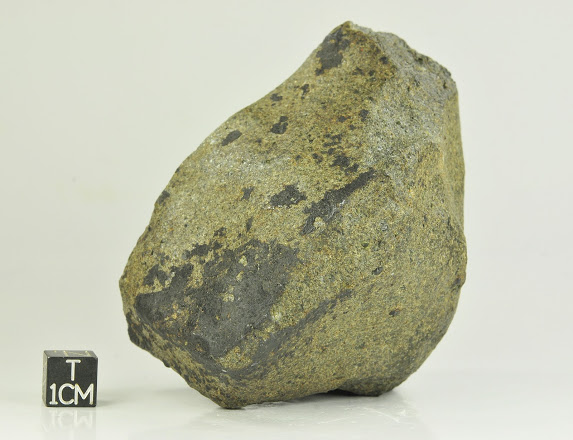
Photo courtesy of Tomasz Jakubowski
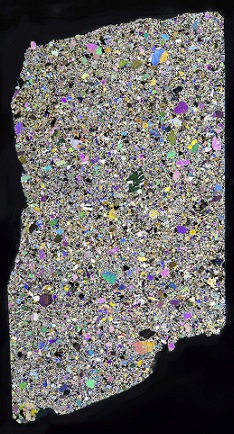 click on photo for a magnified view
click on photo for a magnified view Photo courtesy of Peter Marmet













